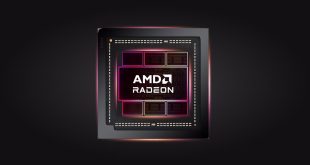Test Setup
Before diving into our benchmark results, it's worth quickly going over some other performance-related details and two power modes on offer from the BIOS. I did get two BIOS updates from Geekom during my time with the machine, and all testing was done on the latest – V1.02, which I am told will be pre-updated to retail units when they ship.
Still, as you can see here, the BIOS itself looks absolutely ancient, straight out of the Windows XP era, and there's very few settings you can actually change. The only thing of real note is the power mode setting, where there's a choice of Quiet, Normal and Performance modes. I tested the latter two and will breakdown the differences below.
Just before that however, it is also worth showing the fan control software that Geekom provided. Again, this looks incredibly janky, it doesn't appear to have an English version, and to use it you have to hit the start button, then choose which fan speed percentage you want to apply to Fan 1 or Fan 2, then hit the Write button to actually apply the setting. By default there is some sort of auto fan curve, though you can't actually set a curve in the software, just one of the 10 fixed speeds.
Power Modes
As mentioned, I tested the Normal power mode which is default, but I also tried the Performance mode as well. The mode only changes CPU power limits and does not affect GPU performance in any way.
The Normal power mode for instance, has a PL2 of 115W but it can only sustain that for about 5 seconds in Cinebench, briefly hitting 4.3GHz on the P-cores before dropping back to the 45W PL1 and 2.9GHz clock speed. After thirty minutes of that, it was rock solid at 2.9GHz and had a steady-state temperature of just over 50C, with a peak of 80C coming during the initial boost period. In games, the CPU would draw about 45W as well, but bounce between 4.1 and 4.2GHz on the P-cores, with package temperatures never exceeding 80C.
The Performance power mode definitely cranks things up a level, with a 120W PL2 where the CPU hit 4.4GHz on the P-cores in Cinebench, before dropping to the 100W PL1. However, even after a minute or two of Cinebench, I noticed certain cores momentarily dropping clock speed down to 2.5GHz, and after 30 minutes this was a very obvious occurrence in Performance mode. CPU package temperature was around the 82-85C mark so I don't think it was thermally throttling, but possible a VRM issue with the tiny laptop-grade hardware not capable of sustaining the higher power draw, with sustained package power now more like 85W. In Cyberpunk 2077, I didn't see this issue as clearly, but clocks were bouncing between 4.5 to 5.1GHz. Temperatures were much more problematic in this mode though, regularly hitting in the upper 90s and peaking at 102C in my testing, and clearly that is just way too hot.
As for the GPU, in game it was pulling about 120W which is to be expected for an RTX 4060, clocking at 2760-2775MHz and with the GPU temp at 68C and hot spot a little below 80C, and this was not affected by the power modes as they only adjust CPU parameters.
My recommendation is definitely to stick with the Normal performance mode. You will lose out on some performance due to the relatively conservative 45W PL1, but at least the CPU isn't going anywhere near 100C and the clock-speed was rock solid instead of dipping down on certain cores as we saw with the Performance mode. I did still test both modes for the following benchmarks.
Comparison Systems
Given the Megamini G1 uses a combination of desktop and laptop components, I tried to use a similar mix of hardware for my benchmark comparisons. We used the follow systems:
Specification:
- CPU: Intel® Core™ i9-14900HX Processor (36M Cache, up to 5.8 GHz, 24 cores : 8 P-core and 16 E-core)
- Video Graphics: NVIDIA® GeForce RTX™ 4070 Laptop GPU 8GB GDDR6, Boost Clock 2175MHz / Maximum Graphics Power 140 W
- Display: 16.0“ 16:10 WQXGA (2560×1600) 165Hz Display (100% sRGB, Pantone® Validated, TÜV Rheinland-certified, Dolby Vision®, NVIDIA® Advanced Optimus, G-SYNC)
- System Memory: 2x DDR5 Slots (DDR5-5600MHz, Up to 64GB)
- Storage: 2x M.2 SSD slots (Supports 2x PCIe® Gen4x4 NVMe™ M.2 SSD, Up to 4TB)
- Keyboard Type: 3-zone RGB Backlit Keyboard, Up to 1.7mm Key-travel (Support N-Key)
Specification:
- Processor – AMD Ryzen™ AI 9 HX 370 Processor 2.0GHz (36MB Cache, up to 5.1GHz, 12 cores, 24 Threads); AMD Ryzen™ AI up to 81 TOPs
- Graphics – AMD Radeon™ 890M Graphics
- Neural Processor – XDNA up to 50TOPs
- Display – 16.0-inch, 3K (2880 x 1800) OLED 16:10 aspect ratio, 0.2ms response time, 120Hz refresh rate
- Memory – 32GB LPDDR5X on board
- Storage – Micron 2400 1TB M.2 NVMe™ PCIe® 4.0 SSD
Specification
- CPU: Intel Core Ultra 7 155H (6P + 8E + 2LP cores/22 Threads) 45W TDP
- Graphics: Nvidia RTX 4060 Laptop 8GB and Intel Arc Graphics
- Screen: 14.0-inch 2.8K (2,880 x 1,800) 120Hz OLED, 400 nits, variable refresh
- Memory: 32GB LPDDR5X-7467 dual channel
- Storage: 1TB WD SN810 Gen 4.0
 KitGuru KitGuru.net – Tech News | Hardware News | Hardware Reviews | IOS | Mobile | Gaming | Graphics Cards
KitGuru KitGuru.net – Tech News | Hardware News | Hardware Reviews | IOS | Mobile | Gaming | Graphics Cards





